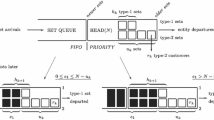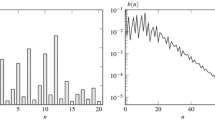Abstract
We consider a single-server queue subject to multiple types of operation-independent interruptions motivated by operations and vessel queueing at entrances of waterways. A case in point is the Strait of Istanbul. We are using waiting-time arguments and service completion time analysis to obtain the expected waiting time of a customer (vessel) in the aforementioned queue with single-class of customers and k non-simultaneous and possibly simultaneous service interruptions. In the analysis, we have used arguments and assumptions from the Strait of Istanbul that are also valid for narrow waterways at large.
Similar content being viewed by others
References
Almaz, A. O. (2006). Investigation of the transit maritime traffic in the Strait of Istanbul through simulation modeling and scenario analysis. MS Thesis, Department of Industrial Engineering, Boğaziçi University, Istanbul, Turkey.
Almaz, A. O., Or, I., & Özbaş, B. (2006). Simulation of maritime transit traffic in the Istanbul channel. In 20th European conference on modelling and simulation ECMS 2006. Modelling methodologies and simulation key technologies in academia and industry (pp. 360–366). Saint Augustin, Germany.
Altiok, T. (1997). Performance analysis of manufacturing systems. New York: Springer.
Bronzini, M. S. (1995). Panama Canal capacity analysis. TN: Oak Ridge National Laboratory.
Elsayed, E. A., & Proctor, C. L. (1979). Two repair policies for a machine interference problem with two types of failures. In Proceedings of the 10th annual modeling and simulation conference (Vol. 10, pp. 535–539). Pittsburgh, PA.
Franzese, L. A. G., Abdenur, L. O., Botter, R. C., Starks, D., & Cano, A. R. (2004). Simulating the Panama Canal: present and future. In Proceedings of the 2004 winter simulation conference (Vol. 2, pp. 1835–1838). Washington, DC.
Golkar, J., Shekhar, A., & Buddhavarapu, S. (1998). Panama Canal simulation model. In Proceedings of 1998 winter simulation conference (Vol. 2, pp. 1229–1237). Washington, DC.
Gray, W. J., Wang, P. P., & Scott, M. (2004). A queueing model with multiple types of server breakdowns. Quality Technology & Quantitative Management, 1(2), 245–255.
Gray, W. J., Wang, P. P., & Scott, M. (2003). A queueing model with service breakdowns and multiple stages of repair. Journal of Applied Statistical Science, 12(1), 75–89.
Hsieh, Y., & Andersland, M. S. (1995). Repairable single-server systems with multiple breakdown modes. Microelectronics and Reliability, 35(2), 309–318.
Jaiswal, N. K., & Thiruvengadam, K. (1963). Simple machine interference with two types of failure. Operations Research, 11(4), 624–636.
Kose, E., Basar, E., Demirci, E., Guneroglu, A., & Erkebay, S. (2003). Simulation of marine traffic in Strait of Istanbul. Simulation Modelling Practice and Theory, 11(7–8), 597–608.
Mavrakis, D., Kontinakis, N. (2008). A queueing model of maritime traffic in Bosporus Straits. Simulation Modeling Practice and Theory, 16, 315–328.
Nicola, V. F. (1986). A single-server queue with mixed types of interruptions. Acta Informatica, 23(4), 465–486.
Norman, R. J. (1973). An algorithm for the scheduling of vessels through Panama Canal. Dissertation (MS (OR)), Naval Postgraduate School.
Otay, E. N., & Özkan, S. (2003). Stochastic Prediction of Maritime Accidents in the strait of Istanbul. In Proceedings of the 3rd international conference on oil spills in the Mediterranean and Black Sea regions (pp. 92–104).
Özbaş, B. (2005). Simulation of maritime transit traffic in the Istanbul Channel. MS Thesis, Department of Industrial Engineering, Boğaziçi University, Istanbul, Turkey.
Palesano, J., & Chandra, J. (1986). A machine interference problem with multiple types of failures. International Journal of Production Research, 24(3), 567–582.
Petersen, E. R., & Taylor, A. J. (1988). An optimal scheduling system for the Welland Canal. Transportation Science, 22(3), 173–185.
Rosselli, A. T., Bronzini, M. S., & Weekly, D. A. (1994). Computer simulation and capacity evaluation of Panama Canal alternatives. In 28th international navigation congress. Seville, Spain.
Tan, B., & Otay, E. (1998). A stochastic model of vessel casualties resulting from oil tanker traffic through narrow waterways. In 12th European simulation multiconference (pp. 881–885). Manchester, UK.
Tan, B., & Otay, E. N. (1999). Modeling and analysis of vessel casualties resulting from tanker traffic through narrow waterways. Naval Research Logistics, 46(8), 871–892.
Author information
Authors and Affiliations
Corresponding author
Additional information
This work is supported in part by the National Science Foundation (NSF OISE-0423262), TUBITAK (104Y207), Turkish Scientific and Technical Research Foundation and by the Rutgers University’s Academic Excellence Fund.
Rights and permissions
About this article
Cite this article
Ulusçu, Ö.S., Altıok, T. Waiting time approximation in single-class queueing systems with multiple types of interruptions: modeling congestion at waterways entrances. Ann Oper Res 172, 291–313 (2009). https://doi.org/10.1007/s10479-009-0613-5
Published:
Issue Date:
DOI: https://doi.org/10.1007/s10479-009-0613-5




